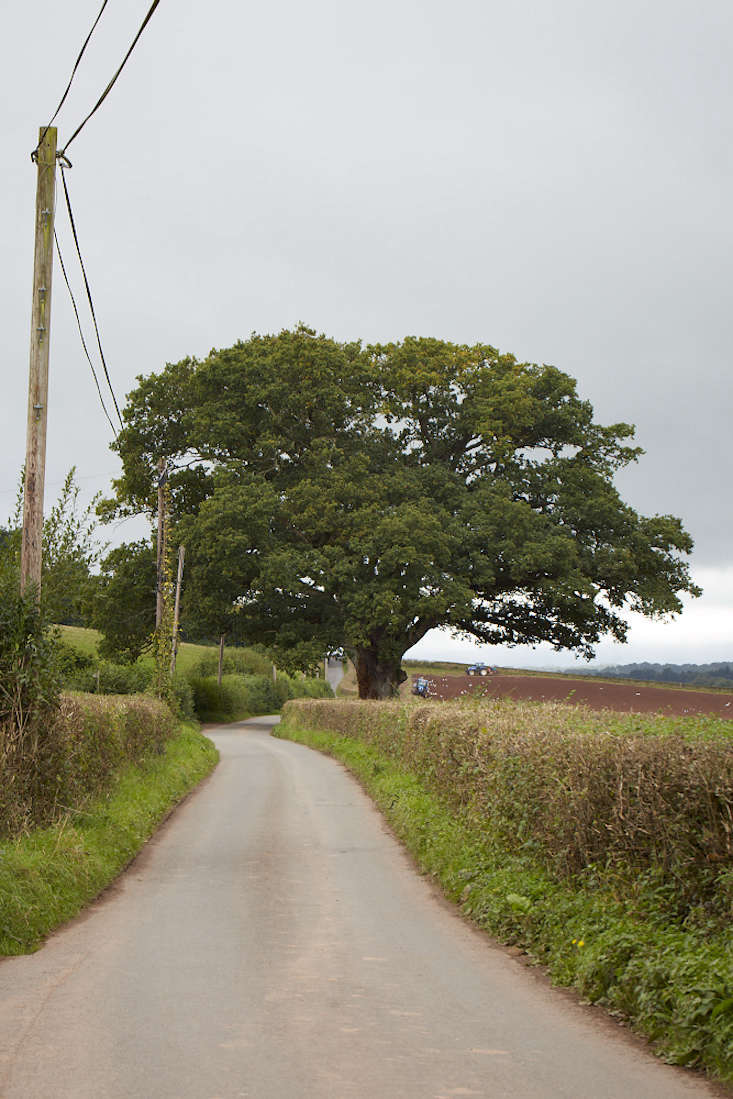Oak (Quercus): “The Lion Heart”
The oak is a leader of trees, a symbol of strength and endurance, and a generous host. As a solitary specimen with remarkable looks, its elegantly turned boughs can make it appear as wide as it is tall. Whether arching over an English lane or dropping its acorns on to Harvard Yard, the oak has soul.
Photography by Britt Willoughby Dyer for Gardenista, except where noted.
Above: There are hundreds of types of oak. English oak (shown here) generally falls into the Quercus robur category, while in the States different types of oak characterize specific regions. The moss-draped Southern live oak (Quercus virginiana) is an evergreen icon of the American South, while its Mediterranean counterpart, holm oak (Quercus ilex), is equally resistant to coastal winds. Cork oak (Quercus suber) is a sustainable source of wine stoppers when grown as a crop; outer layers of bark are trimmed (like hair or nails) without affecting the live tissue beneath.
Above: Acorns do not usually appear for at least 40 years into the life of an oak. They are a food source for mammals and birds on the ground, while the canopy of Quercus robur plays host to a huge variety of insect (and hence bird) life.
Above: Photograph by Marie Brenner. For more of this garden, see A Texas Garden Where the Rare and the Endangered Flourish.
Oak wood is exceptionally hard and durable, and its high tannin content gives it good resistance to pests and diseases. The length and shape of its timber has made oak an integral part of the seafaring success of the British and US navies. Timber-framed buildings of oak stand up to centuries of wear. Green oak, with its high moisture content, is the material of choice for structures put together with wooden pegs for joins. The whole building moves and settles as one.
Above: Photograph by Marie Brenner. For more of this garden, see A Texas Garden Where the Rare and the Endangered Flourish.
Native Americans used acorn kernels to make flour, after removing the tannin with its bitter taste. Tannin from oak is still used for leather tanning.
Cheat Sheet
• If you happen to have an oak in the garden, accept its dominance and make it the focal point.
• The canopy of a deciduous oak is generally light enough to grow spring bulbs underneath. It’s worth researching oaks with lighter canopies, for instance willow oak.
• Evergreen oaks can make good windbreaks around the periphery of a propery, while blending into a native woodland.
Keep it Alive
• There are oaks to suit different situations, whether your soil is acid or alkaline. Many oaks thrive on shallow soil or in poor, compacted soil and they do well in urban situations.
• Ancient oaks are in the landscape, even when they look as though they are dying. Hollowed out trunks continue to sustain insect and animal life.
• Oaks fit perfectly into a sustainable setting with a meadow beneath or in ground cleared by pigs, with acorns enriching their diet.
Above: The relationship between oaks and the parasite world is symbiotic and non-life threatening. Oak is a favorite host for mistletoe and the fungus known as truffles, mainly harvested in France and Italy.
Above: Holm oak was a favorite of British 18th-century landscaper Capability Brown. See more of his ways with trees in England’s Greatest Landscaper: 10 Garden Ideas to Steal from Capability Brown. Photograph by Jim Powell for Gardenista.
For more fungi in the forest, see Weekend Forager: Are Those Mushrooms Edible?
• Mistletoe and ancient oaks are a feature of the deer park at Burghley, Lincolnshire. See: Holiday Aphrodisiac: Why Mistletoe is Welcome at Parties.
N.B.: For more tips on landscape design with trees, see our Garden Design 101 guides:
- Trees: A Field Guide to Planting, Care, and Design.
- Birch Trees 101: A Field Guide to Planting, Care, and Design.
- For another specimen tree see Japanese Maple 101.
Finally, get more ideas on how to successfully plant, grow, and care for oak treea with our Oak Treea: A Field Guide.
Interested in other types of trees? Get more ideas on how to plant, grow, and care for various trees (specimen, deciduous, evergreen) with our Trees: A Field Guide.




















Have a Question or Comment About This Post?
Join the conversation (1)